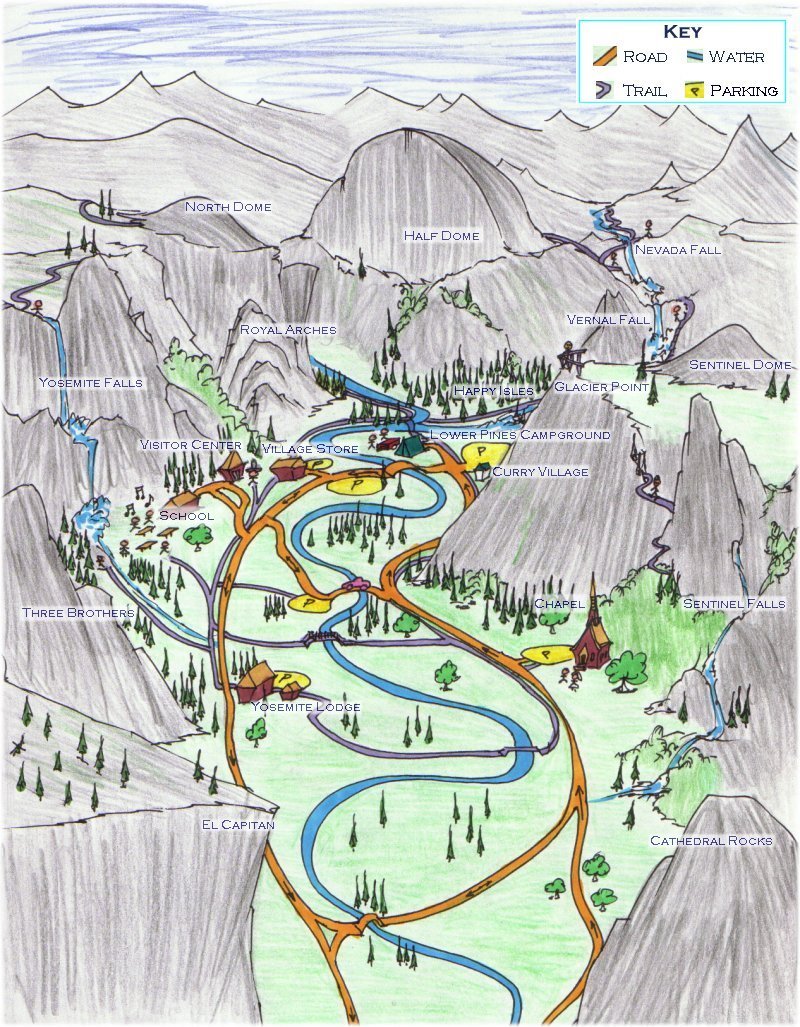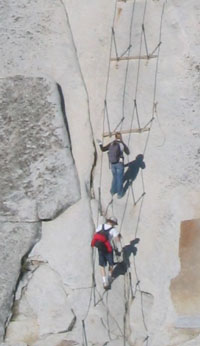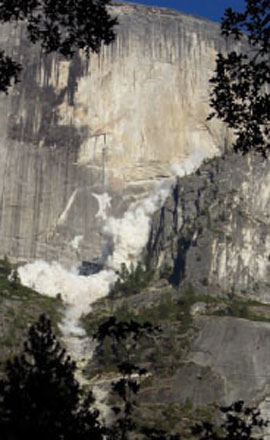I have two more California entries that I want to do, and then it's back to the regular stuff. This is one of the two remaining California topics. Yosemite!
- The word "Yosemite" was the name of a tribe of Native Americans that lived in the valley.
- Actually, they were a collection of fierce people who came from lots of different tribes, including a few Paiutes. They were led by a chief named Tenaya.
- And the name "Yosemite" wasn't the name these people called themselves; it was a name that other tribes called them. The surrounding Miwok tribes were afraid of these people and named them "those who kill," or Yosemite, in their language.
- (Some white guy, by the way, thought Yosemite meant "grizzly bear," so when he named the valley the Yosemite valley, he thought he was naming it after the bears, not the people. He admitted he didn't really understand what Chief Tenaya was saying, but he went ahead and called it Yosemite anyway.)
- The Yosemite people -- the bunch led by Chief Tenaya -- called themselves the Ahwahneechee, which means "dwellers of Ahwahnee."
- Ahwahnee was the name of the largest of their villages, but eventually, that name came to refer to the entire valley. Ahwahnee, sometimes spelled Awooni, means "large or gaping mouth."
- The reason they called the valley "large or gaping mouth" is because that's what it looks like. It was formed by glaciers over the course of 100 million years.

All the green stuff in the middle are trees growing in the Yosemite Valley. That rock sticking up on the right is Half Dome. This photo makes it very apparent how tall Half Dome is (8,842 ft).
(Photo from Dr. Nicholas Short of NASA's page on geology)

Here's another view into Yosemite Valley. As you can see, there's all kinds of stuff going on down there on the valley floor.
(This map and other larger, labeled, and unlabeled versions also available at bluebison.net)
- Now when people say "Yosemite," they're usually referring not just to the valley but the entire national park. Depending on who's counting, it measures somewhere between 1,100 and 1,770 square miles. That's roughly the size of the entire state of Rhode Island.

(Map of Yosemite from Viridian's travelblog)
- Mariposa Grove, down there at the very bottom of the map, is where I saw all those sequoia trees.
There's so much to tell you about Yosemite because it's so huge and all of it is pretty much one jaw-dropping thing after another. I'll do my best to give you the highlights.
- Elevation range: 1,800 feet to 13,000 feet
- Vegetation zones: 5
- Species of vertebrate animals that live in the park: 400+
- Number that are endangered: 40
- Miles of trails: 800
Rocks
- By "rocks," I mean those huge granite formations. Except what's weird is that most of the rocks in Yosemite are forms of igneous rock. That's right, they first came from volcanos. Over time and with huge amounts of pressure or temperature or other shearing, they changed into the granite forms we see now.
- Half Dome, which I mentioned in that photo caption above, is 8,842 feet above sea level and 5,000 feet above the floor of the Yosemite Valley.

All those Ansel Adams photos you've seen for years, they were taken in Yosemite. This one is of Half Dome. My traveling companion and I happened to be there during a full moon, and it looks exactly like this photo. Except it's a little more silvery and shadowy and otherworldly and incredible in real life.
(You can buy this poster from art.com for $29.99)
- It's believed that half of the original rock, or its "sibling" once upon a time sheared away and plunged into the valley below.
- On the way to the top of Half Dome are two sets of waterfalls, Vernal Falls and Nevada Falls.
- Hiking to the top is a 16-mile trip, and because of the 4,800-foot increase in elevation, it takes most hikers 10 to 12 hours or longer.
- Part of the ascent includes a 400-foot section where you have to climb using cables.

Cable ascent to the top of Half Dome
(Photo from the National Park Service)

These people have made it to the top of Half Dome and are looking over the edge. The safe way to look over the edge of an outcropping of rock is to do exactly what these people are doing -- lie down on your stomach and have someone hold onto your ankles. That way, if the rock gives way beneath you, the person holding onto you has somewhat of a chance to keep you from plummeting to your death with the rocks.
(Photo from Kevin's hiking page)
- El Capitan is another granite formation that's a popular challenge for climbers. People on a first-name basis with it call it "El Cap."

El Capitan, seen from Yosemite Valley. I think the water in the picture is Mirror Lake.
(Photo from images-photography-pictures.net)

This is El Capitan seen from a road that goes through Yosemite Valley. Actually, I'm quite a ways away from the road, on a sort of lawn. I had to lie flat on my back to get all of El Cap in the picture.
(Photo by the Apple Lady)
- El Capitan is not as tall as Half Dome -- only 3,000 feet above the valley floor -- but its sheer face makes it much more challenging. It takes most people an average of 5 days to climb the "Nose" part of El Capitan alone, and "the failure rate is high." I saw one guy on TV climbing it. He had to use cables and ropes and get a running start to swing himself out over a chasm so he could ultimately get to the summit.
A climber named Matt de Vaal encountering the great roof which is on the Nose of El Cap.
(Photo by Dave Harbourne on Needle Sports)
- At night, we could see tiny lights from one or two climber's posts on their way up to the summit. Everyone who saw these lights halfway up the side of El Cap said, "They're crazy!"
- While my intrepid traveling companion and I were tromping around in the Yosemite Valley, I'd look up once in a while at these enormous granite outcroppings. Some of them seemed to be teetering pretty precariously up there, and I kept imagining them coming tumbling down the rockface to us wee people in the valley below.
- In fact, rockfalls happen fairly often. Park officials estimate that there have been some 600 major rockfalls in the past 150 years of the park's existence. The most recent rockfall occurred on March 28, 2009.

Rockfall just below Half Dome, July 27, 2006
(Photo from the National Park Service)
- Rockfalls can be caused by the freezing & thawing cycles which make rocks expand and contract with changes in temperature. Or tree roots that enlarge as they grow can shift rocks' positions.
- But scientists don't know much more than that about the causes of rockfalls. Though most rockfalls occur in the springtime, scientists can't predict when they'll occur. They just tell you to be alert.
Waterfalls
- One of the things Yosemite is known for its its waterfalls. There are 8 major sets of waterfalls in Yosemite Valley alone. When I was there (in May, when the waterfalls are at their peak) there was so much snow melt running down all those granite rock faces, it seemed there were waterfalls everywhere. Everywhere I was in the Yosemite Valley area, there was a constant rushing sound from all the waterfalls in the area.
- One of the 8 waterfalls, the Yosemite falls, is the world's 5th tallest falls.
- Actually, it is in three parts, the upper fall, the middle cascades, and the lower fall. The upper fall is about the same height as the Sears Tower in Chicago. All three sections put together roughly equal the Sears Tower plus the Eiffel Tower.

Two of the three parts of the Yosemite Falls
(Photo by your very own Apple Lady)

This gives you another idea of the stages of the Yosemite Falls
(Photo by the Apple Lady)
- Hydrologists estimate that 2,400 gallons of water per second go over the Yosemite Falls.
Bears
- Home to 300 to 500 black bears. Though they're called "black bears," their fur is usually some shade of brown, from dark brown, to cinnamon, to blond.
- Because bears will eat almost anything, and they spend nearly all their time eating, and they have a very powerful sense of smell, you have to be very careful about what you bring into Yosemite. The park will not let you keep any kind of food -- packaged or unpackaged, even canned food -- in your car or cabin or tent overnight because a bear will probably find it and tear up your car or your tent to get it.
- Even shampoo, hand lotion, deodorant, soap, perfume -- anything that has fragrance is verboten as well. If you do have that stuff with you and you're staying overnight, they make you put it in these metal safe-like boxes with special handles that you need to have fingers to open. If they find out you haven't stowed your smelly stuff, they can fine you up to $5,000.

Your basic, everyday view in Yosemite. This is in Camp Curry, near the tent cabins where we stayed. This is what you see when you step outside and look around you: ponderosa pine, incense cedar, and sugar pine, all of which grow about 100-200 feet tall, and in the distance, those enormous granite formations.
If you want to visit Yosemite, this National Park Service page is a good place to start. But there is a ton of information on the web about staying in Yosemite.
P.S. One other thing I meant to say about staying in Yosemite: the people who run this place have thought of everything. You're off on some trail somewhere and you think, dang, I have to go to the bathroom. You turn around, and there's a bathroom. There are all sorts of places to eat, ranging from the fancy and delectable, to the hearty buffet, to the grab-it-out-of-a-cooler-and-go. If you choose to camp there, they have shower houses that are clean and huge enough for everybody and they give you a clean towel, and everything is very well-kept. I give the Yosemite people an A+.
Sources
Dan Anderson, Yosemite Online, Origin of the Word Yosemite
Yosemite National Park Information Page
Don Bain's Waterfalls of Yosemite Valley and Yosemite Falls Facts and Geology
National Park Service, Geology, Rock Formations in Yosemite Valley, Rockfall,
Supertopo, The Nose, El Capitan
Yosemite Vacation, Half Dome Helpful Hiking Information
Excellent entry. You're making me want to travel west.
ReplyDeleteYou should go! You and Mark could stay in the Ahwahnee Hotel.
ReplyDeleteVery informative. Nice photos. But if I was going to Yosemite, I would climb Half Dome!
ReplyDeleteTim O.
Sure, and I'll be right behind you.
ReplyDelete